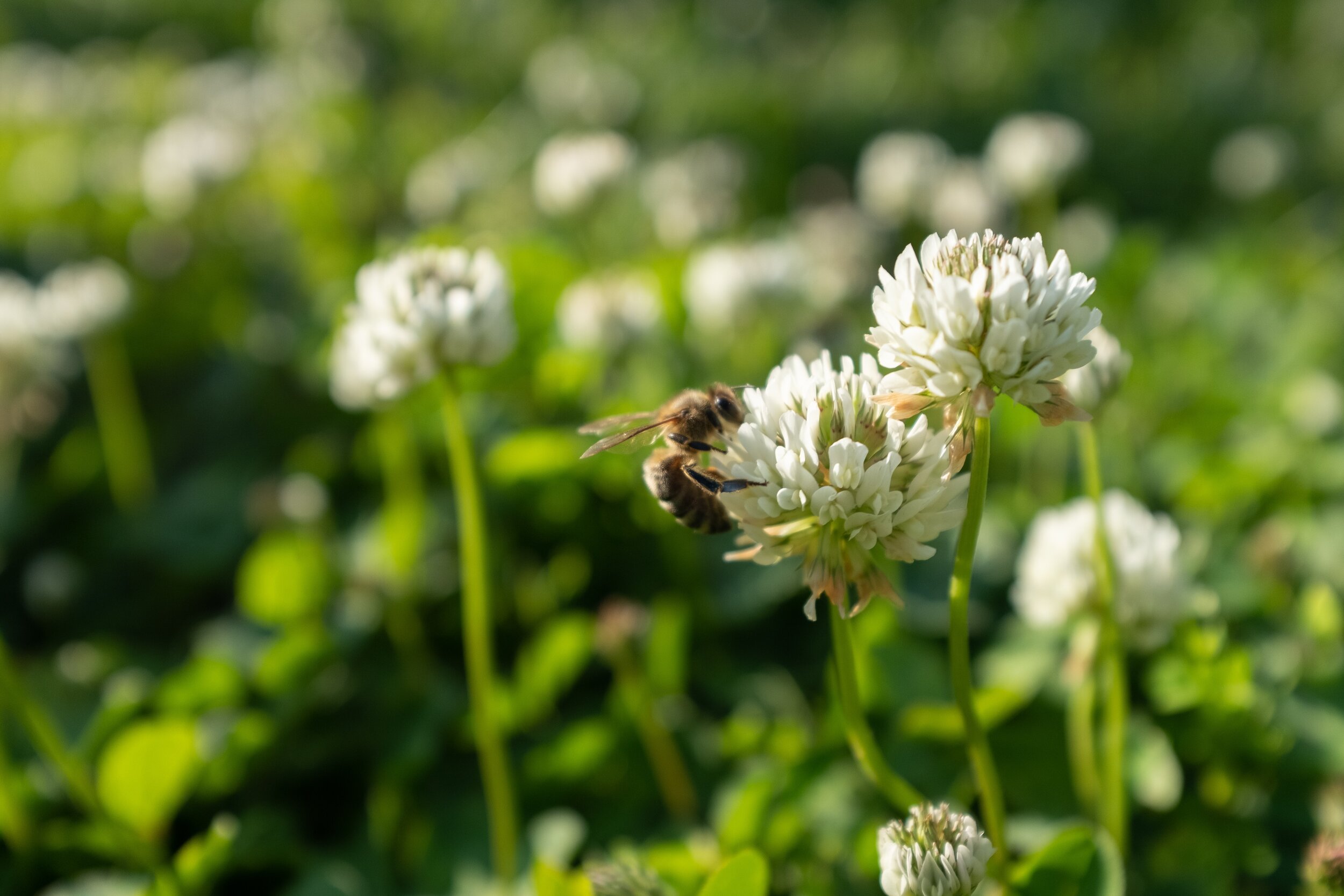In Bloom Among the Vines
Red roses at the end of of a row of vines in Pontéves, France. Photo by Dario Krejci
Vineyard Flowers are More than Just Little Pretty Things
“You know, that mustard out there off River Road is a bonafide health hazard,” a woman working at a Russian River tasting room says.
We’re up on a porch above the treeline, just high enough to take in the great swaths of goldenrod mustard flowers that extend to the horizon.
“Yeah, I tell you what, I’ve seen so many people crane their necks just to look at those flowers, on that road, could be dangerous.”
And they are striking. Dangerous? Maybe, but just to Nematodes - we’ll get to that.
For a period of about two weeks in March, you’ll see this brilliant yellow on your drives between the vineyards of Northern California - and this is very much by design.
Beauty for Beauty’s Sake
The tidy rows carving patterns into flatlands and hillsides, the grape-filled arms of an old vine, the deep variegating green of the canopy - there’s no doubt that agriculture approaches art in the grape vineyard.
Wineries have an incentive to keep their vineyards looking beautiful whether the vines are dormant or not, and this is where plants like mustard can provide a real, financial benefit. Along with candy-corn-colored Tidy Tips, the four-petaled and brilliantly-pink Farewell-to-Spring, and purple antenna-laden Lacy Phacelia, growers plant many flowering crops for the express purpose of keeping things looking pretty when there aren’t vines to look at.
Even hardcore, natural growers like Ted Lemon of Littorai vineyards can’t help but include a few vanity flowers in his cover crop mix, “...good germination is important. In particular, we look for species which will reseed and spread....Flanders Poppy and Bachelor Buttons don’t reseed, but they are so beautiful that we can’t resist having them in the mix. “
Rose bush at the end of a row of vines. Photo by Jason Leung
Underground Rock Stars
To make a very long, significant story very short, Ammonium Nitrate revolutionized agriculture in the United States after World War II when Nitrate factories, then making bombs, converted to making fertilizer. Nitrogen is the most important nutrient in the growth of plants, and is top of mind for any farmer, and artificial fertilizer helps to bring this into crop rows conveniently. But, ammonium nitrate can do some real damage to the soil, discouraging biodiversity, and exhausting it of other important nutrients. Enter clover.
Hank Beckmeyer of La Clarine Farm reflects on his Sierra Foothills vineyards, where he has converted his plots into “do-nothing” vineyards: “...We have dozens of species in our vineyard - many different clovers...and tons of wild sage with a carpet of purple, and blue flowers every spring.”
At Wild Arc Farm, a Hudson Valley permaculture project that also produces wine, founder Todd Cavalo and his wife Crystal began their project in 2016. “We actually seeded Dutch white clover and creeping thyme when first planting our home vineyard. The clover is a Nitrogen fixer.” Clover draws Nitrogen from the air we all breathe to use for its own growth - when leaves fall off, or roots die, its vast nitrogen stores are released into the soil to be enjoyed by, for example, grape vines - this dead matter has been admirably deemed “green manure”.
And, it comes in many colors too! Crimson Clover, or Trifolium incarnatum, is the most dazzling, with its spiky blood-red blooms creating hopeful sanguine rows between vines.
Nitrogen-fixing clover makes an excellent ground cover. Photo by Selina Farzaei
An Armor of Flowers
Flowering plants can also ward against common fungal, bacterial, and animal vineyard agitators.
Cavallo from Wild Arc writes, “since thyme oil is antifungal...we figured why not try to make the vineyard floor inhospitable to mildew…[and it] smells like a pizza shop every time we mow.”
Napa’s mustard certainly has its flavor too, and it is spicy. That makes it a powerful biofumigant - a cover crop planted to deter certain pests from wreaking havoc underground. Nematodes are tiny, subterranean, parasitic worms that feed on plant roots, and they do not like it hot, at all - the mustard matter in the soil keeps their population in vineyards nice and low.
Joe Swick, of Swick Wines based in Oregon and Washington, has planted rose bushes at the end of his vineyard rows, “Roses...are planted...because they show signs of [powdery mildew and black rot] before they appear in grapevines.”
A useful canary for grape growers.
A bee lands on a sunflower, photo by Morais
Go Bugs Go!
The blooms of native flora are naturally attractive to native fauna - namely, insects that prey on the smaller insects that feed on berries, leaves, and roots. It may sound odd, but Vignerons are using native flowers to recruit a rogue’s gallery of insects (assassin bugs, minute pirate bugs, and ladybugs, among others) in order to control smaller vineyard pests like spider mites, leafrollers, and mealybugs, in lieu of spraying harmful insecticides. These flowering big bug sanctuaries are called insectaries.
Ted Lemon, of Sonoma’s renowned Littorai wines uses some familiar flowers just for this purpose, “...we work with native sunflowers and Buckwheat in areas where we see the occasional challenge with leafhoppers. If those don’t do the trick by encouraging leafhopper predators, then a good strong rosemary and artemesia (wormwood) tea takes care of them.”
Healthy vineyards need willing pollinators, and bees love flowers. It’s been shown that greater plant diversity in cover crops encourages larger bee populations - with millions of hectares the world over, there is real potential for reviving the depleted numbers of our flying honey-tailed compatriots.
Pollinator gardens and on-site apiaries are creating their own buzz, as Cavallo writes, “We keep bees on the property as well and have an assortment of pollinator gardens all over with calendula, bee balm, echinacea, lavender, wisteria, black-eyed susans, honeysuckle, coneflower, assorted mints and artemesias.”
Saphron flowers, photo by Mohammad Amiri
A Bouquet of Miscellany
Of course, nothing lasts forever, and that applies to vineyards too. In the Wachau region in Austria, there are many centuries-old vineyard terraces that are no longer productive, and there is an ongoing effort to replace the wild grasses and bushes that cover them with something far more delicious: saffron!
A small collection of farmers are growing the heritage Wachauer Saffron in an effort to revive former vineyard lands and to maybe make a little extra cash.
Veggies under vineyard flowers could even feed your favorite winemaker - Hank writes, “the most successful [interplanted vegetable] was daikon radish, which grew to enormous size without any supplemental water...there is only so much daikon one can eat.“
Like the selection of blooms at your favorite florist, the flowers you’ll find in between grape vines all mean something, and are there for a reason. And isn’t it a beautiful thought, that there is so much unseen magic in a humble flower - not only a symbol of the vitality in a vineyard, but a vital element itself, giving life, protecting vines, and feeding not just the beneficial local bugs and animals, but maybe even a winemaker.
Pink roses at the edge of a row of vines. Photo by Mateus Campos
References:
Rieff et al., “Organic Farming and Cover Crop Management Reduce Pest Predation in Austrian Vineyards.” Insects, March 4th, 2021.
Hightower, Steven. “Insectaries and IPM at Benziger Winery.” University of California Master Gardener Program of Sonoma County. No publish date.
Kratschmer et al., “Enhancing flowering plant functional richness improves wild bee diversity in vineyard inter-rows in different floral kingdoms.” Ecology and Evolution, April 13, 2021.
Kaar, Bernhard. “Wachauer Safran.” The Slow Food Foundation for Biodiversity, no publish date.






